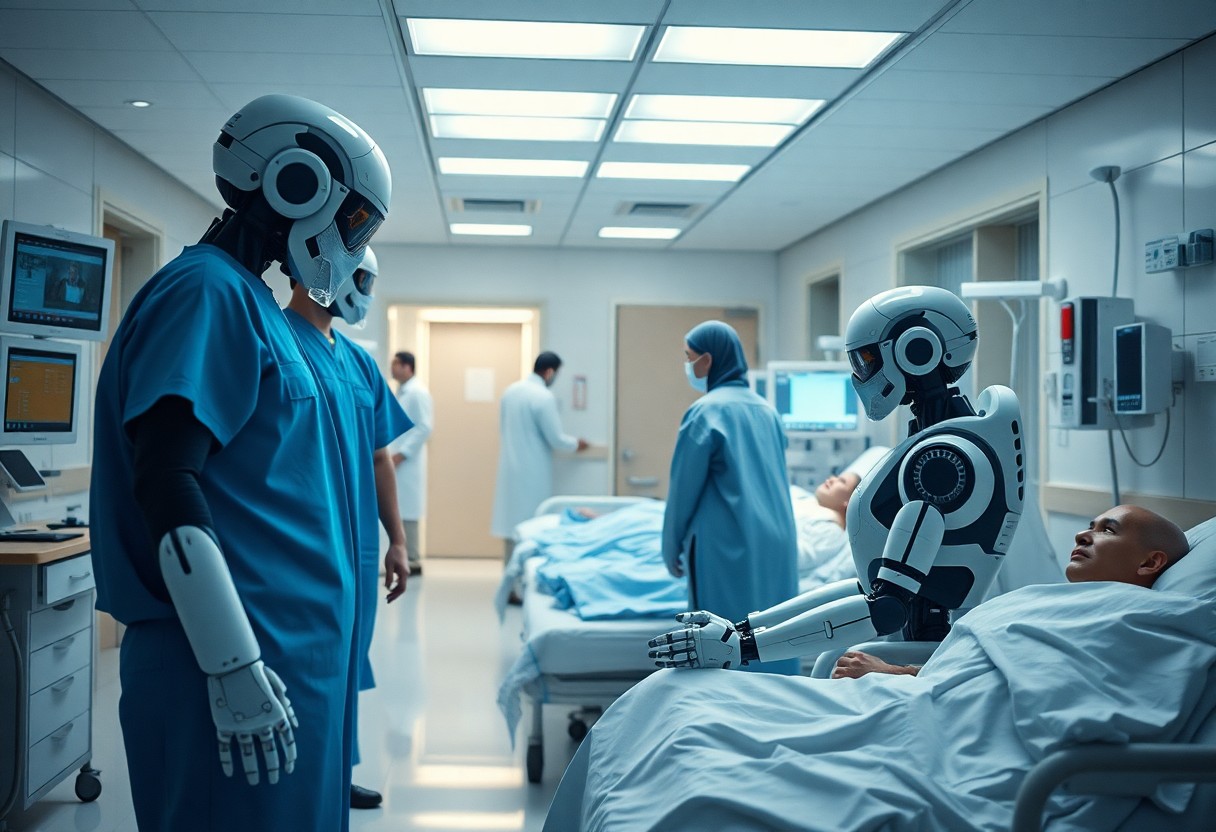There’s a growing need for healthcare professionals to evaluate the role of robots in hospital settings. As you seek to understand their impact, it’s imperative to consider various factors including efficiency, patient care, and staff interaction. This guide will provide you with a systematic approach to assess how these advanced technologies are reshaping modern medicine, ensuring you gain a comprehensive perspective on their benefits and challenges.
Understanding Healthcare Robots
To evaluate the influence of healthcare robots, you first need to understand their nature and capabilities within modern medical facilities. These robots are designed to assist healthcare professionals, improve patient outcomes, and streamline operations. They come in various forms, each tailored to specific tasks, offering a glimpse into the future of healthcare delivery.
Definition and Types of Healthcare Robots
Some types of healthcare robots include:
| Type | Description |
| Surgical Robots | Assist surgeons with precision during procedures. |
| Rehabilitation Robots | Aid patients in recovery through guided exercises. |
| Telepresence Robots | Enable remote consultations and monitoring. |
| Pharmacy Robots | Automate medication dispensing and inventory management. |
Knowing the different kinds of healthcare robots can assist you in assessing their impact on modern healthcare practices.
Current Applications in Modern Hospitals
Current utilization of healthcare robots in hospitals significantly enhances operational efficiency and patient care. These technologies support various processes, from surgical assistance to patient monitoring, thereby reducing workload for healthcare staff and increasing safety in treatments.
Understanding how these robots are applied in hospitals is imperative for recognizing their value. They facilitate tasks such as surgical interventions, rehabilitation sessions, medication dispensing, and even telehealth services. By incorporating these robotic systems, hospitals improve not only the quality of care but also streamline workflows, ultimately leading to a more effective healthcare delivery model. Keeping up-to-date with these applications allows you to grasp the evolving role of technology in healthcare.
How to Assess the Effectiveness of Healthcare Robots
There’s a significant need to systematically evaluate healthcare robots to understand their impact on hospital operations. This assessment involves measuring both quantitative outcomes, such as efficiency and cost savings, and qualitative aspects, including staff satisfaction and patient experiences. By leveraging these evaluations, you can make informed decisions about the integration and future utilization of robotic technology in your healthcare facility.
Identifying Key Performance Indicators (KPIs)
Assess your healthcare robots by first identifying key performance indicators (KPIs) that align with your facility’s goals. These KPIs may include patient turnaround times, the accuracy of robotic-assisted procedures, and the reduction in human error. Establishing these metrics will allow you to track the effectiveness and impact of robotic technologies in your hospital.
Gathering Quantitative and Qualitative Data
Indicators of healthcare robots’ effectiveness come from a mix of quantitative and qualitative data that paint a comprehensive picture of their impact. Quantitative data provides measurable outcomes, while qualitative data offers insights into patient perceptions and staff experiences.
Robots in healthcare settings generate a wealth of data that can be analyzed for ongoing assessment. This data includes numerical results, such as the number of successful procedures performed, alongside personal insights gathered from staff and patient feedback. Together, this information can help you gauge the overall effectiveness of the robots, highlighting both their operational benefits and any areas that may need further improvement. By striking a balance between hard metrics and personal experiences, you can foster a more complete understanding of how robots are performing in your hospital environment.
Tips for Evaluating Patient Outcomes
Some effective ways to assess healthcare robots’ impact on patient outcomes include:
- Analyzing clinical metrics before and after robot implementation.
- Collecting feedback from healthcare professionals who interact with the technology.
- Using patient surveys to gauge satisfaction and quality of care.
- Monitoring any changes in complications or readmission rates.
- Reviewing operational efficiency and workflow improvements.
Any insights gleaned will help you make informed decisions about the integration of robotics in your facility.
Measuring Patient Satisfaction
Measuring patient satisfaction is vital in evaluating the effectiveness of healthcare robots. You can utilize surveys and interviews to capture patient experiences with robotic systems, which provides qualitative and quantitative data. Focus on aspects such as the level of human-robot interaction and how these technologies influence perceived care quality. This feedback can guide further improvements in robotic applications and enhance overall patient experiences.
Tracking Recovery Times and Errors
Any analysis of recovery times and errors can reveal the operational efficacy of healthcare robots. By comparing data from traditional methods to robotic-assisted protocols, you can determine if there are significant differences in recovery times or error rates. This evidence-based approach will empower you to understand strengths and weaknesses in robotic healthcare delivery.
It is imperative to establish metrics for tracking recovery times and operational errors associated with healthcare robots. Examine specific cases where robots are utilized, and compare outcomes against established benchmarks. Consider factors such as length of hospital stay, post-treatment complications, and any reported errors in medication administration or procedures. By consolidating this information, you can develop a clearer picture of how robotic interventions influence overall patient safety and efficiency in modern healthcare settings.
Factors Influencing the Impact of Healthcare Robots
Once again, multiple factors can significantly influence the impact of healthcare robots in modern hospitals. These may include:
- Integration with existing systems
- Cost-effectiveness
- Patient acceptance and trust
- Regulatory compliance
- Technological advancements
- Staff training and adaptation
Any of these factors can shape both the effectiveness and efficiency of robotic systems in delivering healthcare services.
Technological Advancements
Any developments in technology, such as artificial intelligence and machine learning, can enhance the functionality and adaptability of healthcare robots. These advancements contribute to smarter, more efficient robots that can handle complex tasks, improving patient care and outcomes.
Staff Training and Adaptation
There’s no denying that effective staff training and adaptation to new technologies can significantly affect how well healthcare robots are integrated into daily operations. If staff are comfortable and proficient in utilizing these robots, you can expect better collaboration and more efficient workflows.
It is imperative for your hospital to provide comprehensive training programs that not only focus on how to operate the robots but also foster a culture that embraces technological change. When staff feel confident in using these advanced tools, they become more open to innovation, leading to improved patient interactions and care delivery. By investing in staff training, you are ensuring that the full potential of healthcare robots is realized, ultimately benefiting both your team and your patients.
How to Involve Stakeholders in the Assessment Process
Unlike many traditional evaluation methods, involving stakeholders in the assessment process of healthcare robots fosters a comprehensive understanding of their impact. By encouraging collaboration amongst various groups, including medical staff, administrators, and patients, you can gather diverse insights that reflect the experiences and expectations of those directly affected. This collective effort is fundamental in shaping a realistic assessment that addresses both challenges and opportunities presented by robotics in healthcare.
Engaging Medical Staff
Stakeholders, particularly medical staff, play an imperative role in the assessment of healthcare robots. You should actively involve these professionals by conducting surveys and facilitating focus groups where they can share their observations and experiences. By engaging with them, you enhance the assessment process and ensure that the unique perspectives of those who work with healthcare robots daily are considered.
Incorporating Patient Feedback
Engaging with patients is a vital aspect of evaluating healthcare robots. You need to create platforms, such as feedback forms or discussion panels, where patients can voice their thoughts and experiences related to robotic interventions. This engagement not only enriches the data collected but also empowers patients, making them feel valued in the healthcare decision-making process.
Assessment of patient feedback is imperative in understanding the overall effectiveness of healthcare robots. By gathering insights on aspects such as ease of use, comfort, and perceived benefits, you can identify areas for improvement and adapt robotics solutions accordingly. Additionally, considering patient feedback ensures that the innovations in healthcare align with the needs and expectations of those receiving care, ultimately leading to better health outcomes and higher satisfaction levels.
Leveraging Data for Continuous Improvement
All healthcare organizations must focus on utilizing data effectively to enhance the performance of robotics systems. By assessing both qualitative and quantitative metrics, you can pinpoint areas for growth and optimize the use of healthcare robots. Continuous improvement strategies ensure that technology integrates smoothly into workflows, fostering better patient outcomes and operational efficiency.
Analyzing Trends and Patterns
You should regularly review data collected from robotic systems to identify trends that can inform your decision-making. By analyzing patterns such as patient outcomes, operational efficiency, and error rates, you can gain valuable insights that help adapt strategies and refine robotic applications in your hospital. This can lead to smarter resource allocation and improved care delivery.
Implementing Feedback Loops
Data from your robotic systems should be used to create ongoing feedback loops that drive improvement. These loops enable your team to make informed adjustments based on real-time insights from both patients and staff interacting with the robots.
Leveraging feedback effectively allows you to identify not just operational shortcomings, but also user experiences that may require attention. Engaging both clinical staff and patients to gather qualitative feedback can reveal hidden issues affecting robotic applications. Feeding this information back into your data analysis process creates a cycle where your hospital continuously evolves, adapting to the dynamic needs of patient care while improving technology integration and user satisfaction.
Summing up
Hence, to effectively assess the impact of healthcare robots in modern hospitals, you should evaluate key performance indicators such as patient outcomes, operational efficiency, and staff satisfaction. Conducting surveys and analyzing data on how robots enhance or hinder workflows will provide insights into their effectiveness. Engaging with healthcare professionals will allow you to gauge their perceptions and experiences with robotic systems. Finally, maintaining an ongoing review process will enable you to adapt to advancements in technology, ensuring that your evaluation remains relevant and comprehensive.







